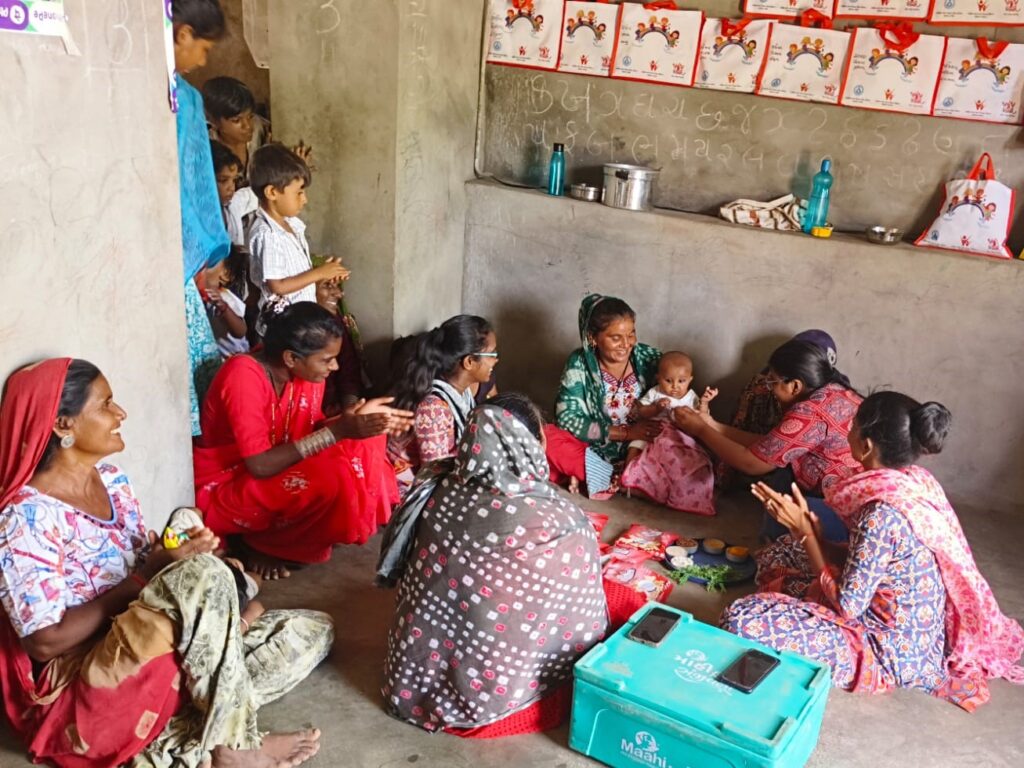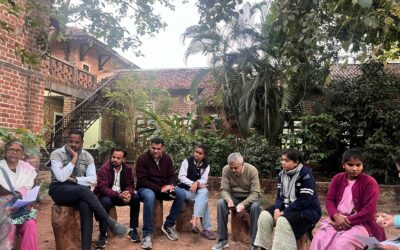On my first field visit with my host organisation Gram Swaraj Sangh, I visited Keshav Bal Vadi, an Aanganwadi run in Rapar taluka of Kutch district at a private rental unit. When I arrived at the Aanganwadi, Sonal Ben, the Aanganwadi worker, and Nisha Ben, the Aanganwadi helper were preparing food. At first, I thought they might be making breakfast for the children who attend the Aanganwadi. However, Sonal Ben explained that they were preparing for the Annapraashan ceremony for a child who was turning six months old.

Why Are We Celebrating Annapraashan In Aanganwadi?
Hearing this piqued my curiosity, as I had never heard of an Aanganwadi performing an Annapraashan before. I began wondering: why was an Annapraashan ceremony being held at an Aanganwadi? What is the purpose of this program? And are women actively participating in this activity?

Annapraashan Sanskar is a widely celebrated Hindu tradition where an infant is fed their first solid meal. The term originates from Sanskrit, where “Anna” means grain and “Praashan” means feeding. Thus, Annapraashan literally translates to feeding the infant their first meal. The ceremony has different names across various regions of India—for example, it is called Mukhe Bhaat in West Bengal, Bhat Kublai in Himachal Pradesh, and Choroonu in Kerala. The grain used is typically cooked rice, symbolising the sacred and life-sustaining nature of food in Hindu tradition.
Poshan Abhyan
POSHAN Abhiyaan, also known as the National Nutrition Mission, is a Government of India initiative launched in March 2018. Its major goal was to improve the nutritional status of children (under 6), adolescent girls, pregnant and lactating mothers. Its primary focus is to prevent:
- Stunting and wasting among children under the age of 6
- Anaemia among women, children and adolescent girls
Poshan Abhyan is working on this mission through:
Technology: Real-time monitoring and improved governance via the Poshan tracker
Convergence: Inter-ministerial collaboration for integrated service delivery
Behaviour Change Communication: Community awareness through Jan Aandolan
Poshan Vatikas: Nutri-gardens for affordable access to nutritious produce and herbs
Training: Over 10 lakh Aanganwadi workers are trained on key implementation modules
Between 2019 and 2021, as per NFHS-5, India showed notable progress in reducing malnutrition among children under 5 years. Stunting (low height-for-age) declined from 38.4% (NFHS-4, 2015-16) to 35.5%, indicating improved growth outcomes. Wasting (low weight-for-height), a critical indicator of acute malnutrition, dropped from 21% to 19.3%.
Gujarat Government’s Initiative: Community Events At Aanganwadis
The Gujarat government, through the Poshan Abhiyan, has taken an initiative to encourage Aanganwadis to hold community events every week. These events are organised every Tuesday.
- On the first Tuesday of the month, a Godbharai event is held, where women are taught about prenatal and postnatal care
- On the second Tuesday, Annapraashan Diwas is celebrated. During this event, the Aanganwadi celebrates a child’s first solid meal and teaches the mother about the appropriate quantity and type of food to feed the child
- On the third Tuesday, Baltula Diwas takes place, where the child’s weight is measured to check whether it is within a healthy range or at a concerning level
- On the fourth Tuesday, a session on health and hygiene is conducted for adolescent girls
This initiative is not yet followed by all Aanganwadis across Gujarat. However, thanks to the efforts of Gram Swaraj Sangh, my fellowship host organisation in developing Aanganwadis in the Rapar region, they regularly organise Annapraashan and other ceremonies.
Urban vs. Rural Aanganwadi Practices
When I attended the ceremony for the first time, I was filled with a sense of joy and excitement. Being new to the experience, Sonal Ben asked me to hold a four-month-old baby boy and weigh him. I couldn’t help but think how delicate and innocent he seemed. Initially, the baby was crying, but the moment I placed him in the weighing bag, he stopped crying and began to smile. It was such a surreal and heartwarming moment for me. Later, I also had the privilege of performing the Annapraashan in Aanganwadi for a baby who had just turned six months old.

Coming from a city where these rituals seemed just another task to be done for society, and maybe it was true there where there is no rampant malnourishment or such a high anaemia level. But as I got to understand the state of children in the hamlets of Rapar, I understood the need of this tradition. To satisfy my curiosity, I talked to several people working in different Aanganwadis arranging for Annapraashan and other ceremonies.
In urban regions it was a hope that was bringing light to the lives of those children by educating their parents on how to protect them from malnutrition and anaemia. But in rural regions it was just another task that the Aanganwadi worker had to do. There was no visible change that was seen; the mothers in Hamlet were, except for a few, still following the same habits of feeding their child everything.
One of the Aanganwadi workers said, “whatever we do, there is no hope for these children, as they will remain malnourished; nothing will change.”
This statement broke my heart. It left me pondering, what hope would a child have whose only space is Aanganwadi?
Also Read: Gujarat Among Worst In Child Nutrition And Hunger: NITI Aayog Report




0 Comments